Spinthariscope
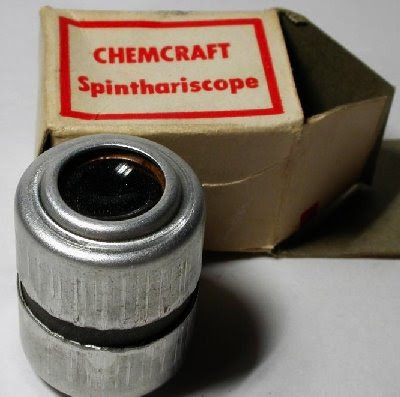
"William Crookes and the Turbulent Luminous Sea"
Paul W. Frame
Oak Ridge Associated Universities
(This article originally appeared in the Health Physics Society Newsletter)
London, 1903. Sir William Crookes, the very picture of Victorian elegance, was entertaining himself by observing the fluorescence that alpha rays from radium produced on a zinc sulfide screen (Romer 1960). But accidents happen, and Crookes spilled some of the radium. Eager to locate and recover it, Crookes inspected the screen under a microscope. And what he saw astonished him! Rather than the expected uniform glow, he observed discrete flashes of light - each flash produced by an individual alpha particle!
Inspired, Crookes built an amazingly simple device that provided a convenient way to view these scintillations. As he described its construction in The Chemical News (Crookes 1903): "fit the [zinc sulfide] blende screen at the end of a brass tube with a speck of radium salt in front of it . . . about a millimeter off, . . . a lens at the other end."
The position of the radium, affixed at the end of a needle, could be adjusted by means of a thumbscrew. Crookes described the effect of such an adjustment as follows: "on bringing the radium nearer the screen the scintillations become more numerous and brighter, until when close together the flashes follow each other so quickly that the surface looks like a turbulent, luminous sea."
Such a miraculous instrument required a suitably wondrous name and Crookes obliged: "I propose to call this little instrument the Spinthariscope from the Greek word scintillation." To Lawrence Badash (1964), it was only natural that the eloquent Sir William chose the name from Homer's Hymn to the god Apollo.
Crookes' spinthariscope made its first public appearance at a special soiree of the British Royal Society, May 15, 1903. The creme de la creme of the social and scientific elite were there to rub shoulders and take in the spectacular exhibits on display, e.g. recent developments in wireless telegraphy, poisonous sea-snakes, and archeological expeditions in Crete. But it was the spinthariscope, the piece de résistance, that lit up that star-studded evening (Keller 1983).
Soon everyone had to have one. Gentlemen and ladies carried them in pockets or purses, ready to bring them out at an opportune moment and demonstrate the latest in atomic instrumentation. Children received spinthariscopes as presents - no doubt leading to many a career in the sciences.
Even today, most of us think of the spinthariscope as a childhood toy (e.g., the Lone Ranger Atom Bomb Ring). But the spinthariscope was far more - it was the first radiation counter! Earlier devices for measuring radiation (e.g., photographic plates, electrometers, electroscopes) were integrating instruments, but the spinthariscope detected individual decay events!
The spinthariscope used in scientific investigations was quite different from what Crookes had described in The Chemical News - a microscope, not a hand-held lens, was employed to visualize the scintillations. Furthermore, its use was far from entertaining - counting scintillations was difficult, tedious work. Long periods of adaptation in the dark were required before the researcher was ready. And once begun, the counting was extremely hard on the eyes. One or two minute counts with long breaks in between were the rule.
Despite its difficulty of use, the spinthariscope proved its worth.
It was the spinthariscope that seems to have permitted the first application of coincidence counting in the nuclear sciences (Rutherford et al, 1930). In 1924, Geiger and Werner simultaneously counted scintillations on the same zinc sulfide screen by employing a microscope with dual oculars. They independently registered their counts by marking a moving tape. Geiger's marks appeared on one edge of the tape while Werner's appeared on the other. The number of counts by Geiger can be designated CG, and the counts from Werner can be CW. The number of times they simultaneously observed a scintillation (i.e., their marks appeared immediately opposite each other on the tape) can be designated CGW. If N is the actual number of scintillations on the screen and the counting efficiencies of Geiger and Werner are EG and EW respectively, it follows that:
CG = EG N
CW = EW N
CGW = EG EW N
Now, with the following equation, Geiger and Werner were able to calculate the actual number of scintillations on the screen, and hence, the number of alpha particles striking the screen!
N | CG CW | |
= | ||
CGW |
That's not all! Ernest Rutherford and Hans Geiger also used the spinthariscope to measure the charge on an alpha particle - work that provided crucial evidence that the alpha particle was a helium nucleus. Their measurements also helped refine the accepted values for Avogadros number and the charge on an electron. In addition, it was a chance observation with a spinthariscope that led Rutherford to propose his nuclear model of the atom!
The spinthariscope of William Crookes - QUITE A TOY!
References:
Badash, L. The Early Developments in Radioactivity, with Emphasis on Contributions from the United States. Ph.D. dissertation, Yale University; 1964.
Crookes, W. Certain Properties of the Emanations of Radium. Chemical News; Vol. 87:241; 1903.
Keller, A. The infancy of atomic physics: Hercules in his cradle. Clarendon Press; Oxford; 1983.
Romer, A. The Restless Atom. Doubleday & Company, Inc.; Garden City; 1960.
Rutherford, E., Chadwick, J., and Ellis, C.D. Radiations from Radioactive Substances. Cambridge University Press; Cambridge; 1930.
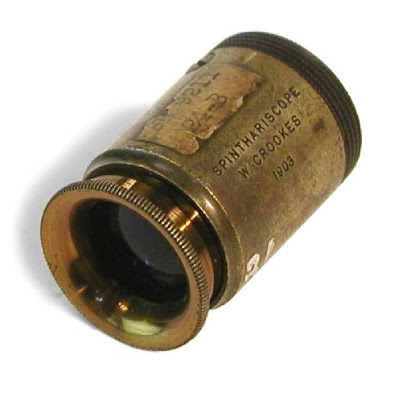
Sir William Crookes' Spinthariscope
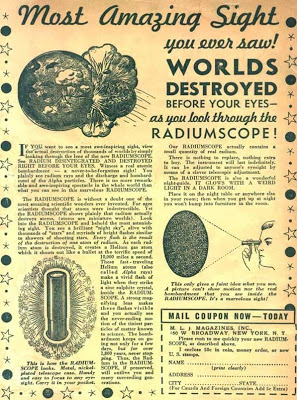 Radiumscope
Radiumscope
[Click to enlarge to read the text.]
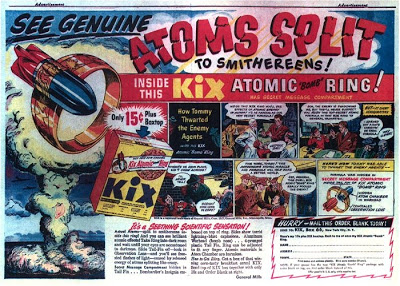
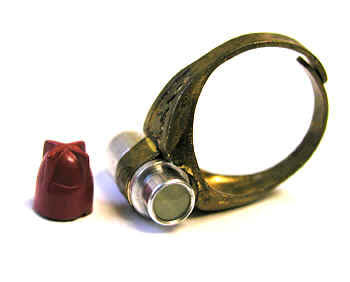
This ring spinthariscope was known as the Lone Ranger Atom Bomb Ring and advertised as a "seething scientific creation." The Lone Ranger was more closely associated with silver bullets than atomic bombs but that's what it was called. When the red base (which served as a "secret message compartment") was taken off, and after a suitable period of time for dark adaptation, you could look through a small plastic lens at scintillations caused by polonium alpha particles striking a zinc sulfide screen. Distributed by Kix Cereals (15 cents plus a boxtop), the instructions stated: "You'll see brilliant flashes of light in the inky darkness inside the atom chamber. These frenzied vivid flashes are caused by the released energy of atoms. PERFECTLY SAFE - We guarantee you can wear the KIX Atomic "Bomb" Ring with complete safety. The atomic materials inside the ring are harmless."
It has been difficult to determine exactly what radioactive element was used for some sources indicated a bit of uranium or radium, but most favored polonium 210 that had a halflife of about 138 days.
I still have mine and they can fetch $125...and up if that precious shipping box was retained. Maybe there is a lesson to be learned--don't throw away any science toys.
Case in point:
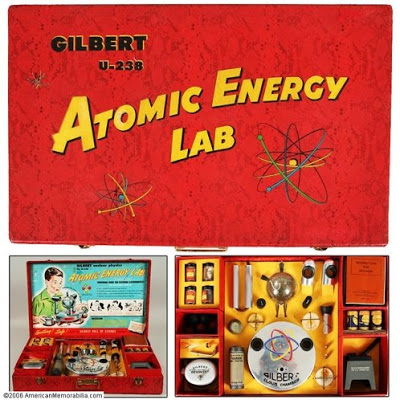 Science can yield technologies that can grease the economic wheel--so can an old science toy: The A. C. Gilbert "U-238 Atomic Energy Lab" issued in 1951. The A. C. Gilbert chemistry sets were enormously popular and existing sets do command a premium but nothing like the physics set.
Science can yield technologies that can grease the economic wheel--so can an old science toy: The A. C. Gilbert "U-238 Atomic Energy Lab" issued in 1951. The A. C. Gilbert chemistry sets were enormously popular and existing sets do command a premium but nothing like the physics set.The A. C. Gilbert "U-238 Atomic Energy Lab" was auctioned on December 14th, 2006 and sold for $7, 944.
Here is the auction description:
(Complete)
A. C. Gilbert was a man of true inspiration, often compared to Walt Disney for his creative genius. Gilbert had high expectations of America's youngsters, and with such he tried to help the future engineers, doctors and leaders by providing toys worthy of their imaginations. As the inventor of the Erector Set, and seeing its commercial appeal, then he and his company set a higher goal. They became the leading manufacturer of scientific toys (chemistry sets) and construction sets (Erector), all of which gained wide acclaim at the retail level.
Interested in the joy of science more than remuneration, however, Gilbert created the Atomic Energy Lab U-238 -- with the help of MIT's able faculty. The toy was made to de-mystify the perils of nuclear energy and to encourage the understanding of chemistry, physics and nuclear science -- ultimately helping kids (and adults) become more open to the possibilities these disciplines offer.
This educational composite, which was marketed during 1950-51, sold for $49.50 -- a very high price for a toy set, even by today's standard. One such, Gilbert's "Atomic Energy Lab," is here available and it includes all the original componentry which detail:
1. U-239 Geiger radiation counter.
2. Electroscope to measure radioactivity of different substances.
3. Spinthariscope to watch "live" radioactive disintegration.
4. Wilson Cloud Chamber to see paths of electrons & alpha particles at 10k mps
5. Three very low-level radioactive sources (Alpha, Beta, Gamma).
6. Four samples of Uranium-bearing ores
7. Nuclear Spheres (used to visual build models of molecules)
8. The book "Prospecting for Uranium"
9. The "Gilbert Atomic Energy Manual"
10. The comic book "Learn How Dagwood Splits the Atom"
11. Three "Winchester" Batteries (size "C")
All of these components were retail-presented in a sturdy, hinged case that measures 25" x 16 1/2" x 5", all with an easy-to-carry handle. The case came in beautiful faux snake skin cover with "Gilbert U-238 Atomic Energy Lab" wonderfully stenciled on the cover, and atomic particles displayed below.
The set we offer here is truly amazing in that it has all the original pieces in remarkable and apparent unused condition. The case remains in its wonderful red color with minimal wear to the surface, and survives in very strong EX/MT condition. Inside the cover, there appears a full dimension, illustrated paper appliqué which is in Excellent condition, qualified only by a couple small stains and handwritten pricing. The remainder of the contents are still intact, and though appearing unused, they have lain dormant for over half a century and appear in EX/MT condition. The two books are still in EX/MT-NM condition, with the comic book in Excellent (taped spine). Last, but not least, included is an original Gilbert Toys catalog from 1951 which provides an ad for the Atomic Energy Lab. The book is in VG/EX condition.
Overall, the entire set (remarkably still complete) is a true find and though we can't physically go back to the time when atomic energy and toys were as fascinating as this, we may reminisce in how much fun it was to be a kid.
Associated with the A. C. Gilbert "U-238 Atomic Energy Lab" were other physics toys such as the folowing.
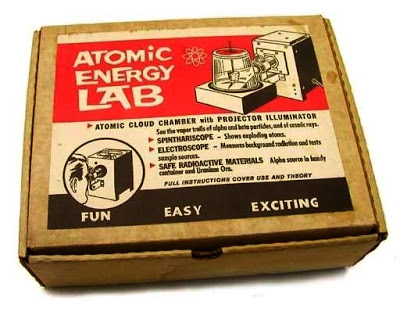
Porter Atomic Energy Kit [late 1940s, 1950s]:
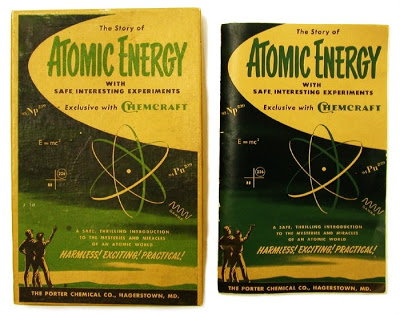
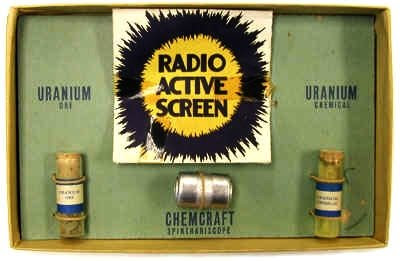
Oak Ridge Associated Universities:
This is a Model No. 100 "atomic energy kit" produced by Porter Chemical Co. under the "Chemcraft" trademark. Based on the copyright date of the instruction booklet, 1947, I am guessing that this set dates from the late 1940s or 1950s. It contains a "radioactive screen", a standard spinthariscope, and two glass vials one of which contains uranium ore while the other contains a "uranium chemical." The "radioactive screen" is simply a small (ca. 1") piece of heavy paper on which radium has been deposited. The spinthariscope contains radium which according to the booklet is "one of the most valuable substances in the world. Radium costs about $25,000 per gram." For the most part, the booklet is a primer on radioactivity. The few experiments described in it consist of placing the uranium samples or the "radioactive screen" against photographic film. In one experiment, they recommend using filters (e.g., lead foil) to see the effect on the photographic image.
Oak Ridge Associated Universities
- In Praise Of Ernest Marsden
Tomorrow would be the 122nd anniversary of the birth of Ernest Marsden, the man who discovered the nucleus for the man who discovered the nucleus. As an undergraduate at the University of Manchester studying physics, Marsden became a laboratory assistant...
- Gilbert U-238 Atomic Energy Laboratory Redux
An excerpt from A. C. Gilbert's autobiography: The Man Who Lives In Paradise... The most spectacular of our new educational toys was the Gilbert Atomic Energy Laboratory. This was a top job, the result of much experimentation and hard...
- Radioactive Disintegration, Discovery Of The Atomic Nucleus, Artificially Produced Element Transformation--ernest Rutherford's Early Experiments
Abstract:Modern atomic and nuclear physics took its start in the early part of the twentieth century, to a large extent based upon experimental investigations of radioactive phenomena. Foremost among the pioneers of the new kind of physics was Ernest...
- Canadian Physicist...harriet Brooks
Harriet Brooks July 2nd 1876 to April 17th, 1933 Canadian nuclear physicist who was probably the first to observe the recoil of the atomic nucleus as nuclear particles were emitted during radioactive decay. During the years 1901-05, she contributed much...
- Problem With Radon?
Now one has to wonder about this issue of significant human fatalities attributed to radon as compared to other carcinogenic villains. The Environmental Protection Agency claims there are 20,000 deaths each year due to radon exposure--a broader range...
